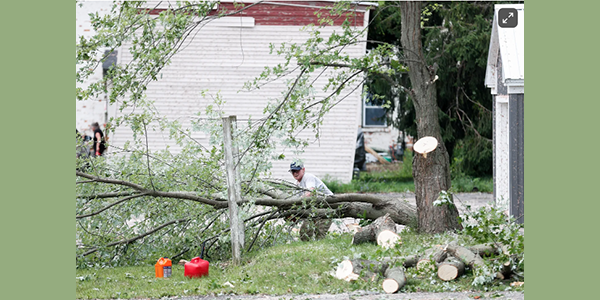How many climate blows before communities start to break?
||| BY BILL MCKIBBEN on SUBSTACK |||
All week, as I’ve helped cut storm-fallen trees, a phrase has been echoing in my brain. It came from an early insurance industry report on climate change, way back in 2005—really, before too much of anything had begun to happen. Swiss Re, the reinsurance giant, had hired a team at the Harvard School of Public Health to study what would happen if repeated disasters struck communities as a result of a warming atmosphere. It was a long report, and it managed to combine the language skills of academics and insurance salesmen, but if you read it carefully the bottom line was unmistakable. What they concluded was that:
In effect, parts of developed countries would experience developing nations conditions for prolonged periods as a result of natural catastrophes and increasing vulnerability due to the abbreviated return times of extreme events.
I live in the northeast U.S., which has been dealt with less harshly by climate change than many other regions. But harshly enough to start to viscerally understand what they were talking about in that long-forgotten report. Once or twice you rise to the occasion; eventually, though, it starts to get a little overwhelming.
In Vermont last week, on the exact anniversary of the record flooding from 2023, a round of wild rainstorms—some places saw nine inches in a matter of hours which, given the state’s steep hills and narrow valleys, was enough to make sure plenty of places were underwater. It wasn’t as widespread as last year, but even worse in some places.
As it happened, I was set to cross Lake Champlain a few days later, to the Adirondacks of upstate New York, the wildest part of the east and the place I’m most at home on this planet. We were staying in the house where we lived for decades, way out in the woods—the house where our daughter was born, and where our grandson will have his naming ceremony in a few weeks. And late on Tuesday afternoon, after 48 hours of the most humid weather I can recall there, the most violent storm I’ve ever lived through suddenly erupted. It didn’t last longer than four minutes, but those 240 seconds were more than enough—instantly trees were bent double, and then broken. It looked like those hurricane shots from the Weather Channel, except that instead of palms bending in the wind there were giant pines and cedars snapping, or coming up from the roots; the wind was so high (over 90 mph at the nearest town with a weather station) that the deluge of rain was blowing up and across as much as down. When it was done and we went outside the damage was almost incredible: trees down on the roofs of the houses nearby, trees by the dozens across the road to town (which was entirely impassable for at least a day), wires dangling in every direction.
We’re okay—there’s not going to be power for a long time, I don’t think (I’m writing this from a town within driving distance where the damage was not as bad) but we have good friends and neighbors, who have the right tools, and we’re getting things at our house slowly back in shape. And our system retains enough money and momentum to, at least for now, make vigorous attempts at recovery—the power company has linemen in from all over, slowly trying to piece the system back together. (The guy I talked to last night was from Wisconsin; he had already been deployed to Chicago and Minnesota this week, basically following the same rampaging front across the country). We will survive. We don’t yet have ‘developing nations conditions’—save your sympathy for those developing nations, where the grief from something like this is far far worse.
But even here, in the rich world, all this starts to take a toll. The Vermont floods were the aftereffects of Hurricane Beryl, at one point in its journey across the Caribbean one of the earliest Category 5 storms on record. It crashed ashore near Houston, where it knocked out power for millions, the second big storm-caused outage in a couple of months. As J. David Goodman reported for the Times:
Houston is no stranger to natural disasters, but living through two crippling power outages in two months has driven some in the city to consider what may be the ultimate evacuation plan: moving out.
The more powerful of the storms, Hurricane Beryl, devastated the power infrastructure over nearly the entire city. When it hit, thousands of people were already living in shelters and hotels, according to state officials, because they had been displaced by an earlier weather event, the spring thunderstorms that caused wind damage and flooding.
Driving around Houston, it can be hard to tell which of the storms that crashed through the city had mangled the highway billboards, torn out the fences or knocked down the trees still strewn along roadsides.
Everyone knows how long it took to get their power back from the first big storm — and when they lost it again. A second round of spoiled food. Of sweltering temperatures. Of emergency plans. In many cases, of repairs to homes that were damaged in the major May storm had yet to be finished when Beryl arrived as a Category 1 hurricane.
As the Houston Chronicle editors put it , “Beryl was the weakest a hurricane could be. Why does it feel like Houston isn’t the same?”
I think it’s that repeat factor, the blows that feel like they’ll just keep coming.
**If you are reading theOrcasonian for free, thank your fellow islanders. If you would like to support theOrcasonian CLICK HERE to set your modestly-priced, voluntary subscription. Otherwise, no worries; we’re happy to share with you.**








